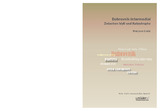Citation link:
http://dx.doi.org/10.25819/ubsi/4439Files in This Item:
| File | Description | Size | Format | |
|---|---|---|---|---|
| Erstic_Dubrovnik intermedial.pdf | 5.57 MB | Adobe PDF |  View/Open |
| Dokument Type: | Book | metadata.dc.title: | Dubrovnik intermedial | Title addition: | zwischen Idyll und Katastrophe | Other Titles: | Dubrovnik intermedially : between idyll and catastrophe | Authors: | Erstic, Marijana | Institute: | Fakultät I Philosophische Fakultät | Free keywords: | Dubrovnik, Ragusa, Heinrich von Kleist, Hermann Bahr, Miroslav Krleža, Kroatienkrieg 1991-1995, Inter University Centre of Dubrovnik | Dewey Decimal Classification: | 800 Literatur | GHBS-Clases: | KLFD | Issue Date: | 2020 | Publish Date: | 2020 | Series/Report no.: | Reihe Medienwissenschaften | Source: | Siegen: universi - Universitätsverlag Siegen, 2020. - ISBN 978-3-96182-053-5 | Abstract: | Ragusa, heute Dubrovnik, ist einzigartig. Die Stadtrepublik war über sechs Jahrhunderte (zwischen 1204–1808) inmitten der Großmächte Venedig/Österreich-Ungarn/Osmanisches Reich unabhängig, stets freiheitsliebend und freiheitsverherrlichend. Obgleich selbst Shakespeare (1564–1616) von Illyrien wusste, wie in der Komödie Twelfth Night (1623) zu entdecken, erwacht im deutschsprachigen Raum das Interesse an Ragusa erst im 19. Jahrhundert. Daran ist Napoleon (1769–1821) schuld: 1808 wird die Stadtrepublik vom napoleonischen Marschall Marmont (1774–1852) abgeschafft. 1815, nach dem Fall Napoleons, wird sie auf dem Wiener Kongress der Habsburger-Monarchie zugesprochen und bleibt als ein Teil der sog. Illyrischen Provinz bis zum Ende des ersten Weltkrieges in ihrem Hoheitsgebiet. Insbesondere vom Anfang des 19. Jahrhunderts an kann man im deutschsprachigen Raum ein verstärktes Interesse an der Stadt beobachten, auch in literarischen Kreisen. Während sie in den Jahrhunderten davor als ein idyllischer Ort beschrieben wird, wie z.B. bei Marin Držić (1508–1567), William Shakespeare oder Ivan Gundulić (1589–1638), wird sie nun bevorzugt als ein Ort der Katastrophe angesehen: Am Anfang der Novelle Der Findling (1811) Heinrich von Kleists (1777–1811) und in der dramatischen Erzählung Marino Caboga (1814) Achim von Arnims (1781–1831). Und wie ist es heute? Dubrovnik ist seit dem 19. Jahrhundert eine Touristen- und Medienmetropole, wie dies Werke von Hermann Bahr (1863–1934) und Miroslav Krleža (1893–1981), aber auch die z.T. in Dubrovnik gedrehte US-Serie Game of Thrones (2011-2019) zeigen. Nicht erst seit heute schreibt also die Stadt an einer globalen Literatur-, Kultur- und Mediengeschichte mit. Dieser intermedialen Geschichte Dubrovniks geht das Buch nach. Ragusa, now Dubrovnik, is unique. The city republic was independent for over six centuries (between 1204 and 1808) in the midst of the great powers of Venice/Austria-Hungary/Ottoman Empire. Although even Shakespeare (1564-1616) knew of Illyria (Ragusa), as seen in the comedy Twelfth Night (1623), interest in Ragusa in the German-speaking world only awakened in the 19th century. Napoleon (1769-1821) was to blame for this: in 1808 the Republic of Ragusa was abolished by the Napoleonic Marshal Marmont (1774-1852). In 1815, after the fall of Napoleon, at the Congress of Vienna, it was awarded to the Habsburg Monarchy and remained an integral part of the Illyrian Province until the end of the First World War. From the beginning of the 19th century, there was an increased interest in the former Republic of Ragusa in German-speaking countries, also reflected in literary circles. While in the previous centuries it was described as an idyllic place, as for example by Marin Držić (1508-1567), William Shakespeare or Ivan Gundulić (1589-1638), 19th century authors preferred to see it as a place of catastrophe: At the beginning of the novella Der Findling (1811) by Heinrich von Kleist (1777-1811) and in the dramatic narrative Marino Caboga (1814) by Achim von Arnim (1781-1831). And how is it today? Since the 19th century Dubrovnik has been a tourist and media metropolis, as shown by Hermann Bahr (1863-1934) and Miroslav Krleža (1893-1981), but also by the US series Game of Thrones (2011-2019). So, it is not only since today that Dubrovnik has been contributing to a global history of literature, culture and media. The book follows this media history of Dubrovnik. |
DOI: | http://dx.doi.org/10.25819/ubsi/4439 | URN: | urn:nbn:de:hbz:467-16944 | URI: | https://dspace.ub.uni-siegen.de/handle/ubsi/1694 | License: | http://creativecommons.org/licenses/by-sa/4.0/ |
| Appears in Collections: | Universi Publikationen aus der Universität Siegen |
This item is protected by original copyright |
Page view(s)
991
checked on Nov 28, 2024
Download(s)
1,134
checked on Nov 28, 2024
Google ScholarTM
Check
Altmetric
This item is licensed under a Creative Commons License


